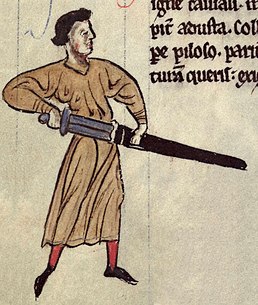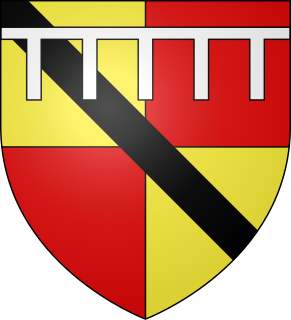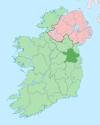Feudal History
The Normans landed in Ireland in 1169 and captured the Danish city of Waterford. It is likely that the only cities or strongholds in the country at the time were those founded by the Danes, and of these the most important was Dublin, which was captured soon afterwards by Milo de Cogan and successfully held by him in spite of a long siege by Ruaidrí Ua Conchobair, the High King of Ireland, who had the co-operation of the Danes.
Henry II of England arrived in Dublin in 1172 and many of the Gaelic Chieftains made their submission to him, i.e., they recognised him as their feudal lord, who gave them the right or title to the lands they held. In other words, Henry applied to Ireland the Norman or feudal system of land tenure which prevailed on the continent and which the Normans introduced into England. This meant displacing some of the native kings – one of whom was the king of Meath or Tara.
Henry granted Hugh de Lacy "the land of Meath in as full a measure as Murchadh Ó Maoilsheachlainn or anyone before or after him held it." The technical name of this grant was a Liberty and it meant that, within his Liberty, de Lacy’s power of jurisdiction was equal to that of the king himself with one reservation, that the king could dispose of Church lands anywhere. The person enjoying such liberal delegation of royal jurisdiction was known as a Count and the territory over which he ruled was called a county. One of the privileges of a Count Palatinate, such as de Lacy in this case, was that he could create barons or inferior lords who held their land from the Count. Some time after 1196, the son of Hugh de Lacy, named Walter, granted "the whole land of Rathtowth" to his younger brother, Hugh. Hence we have now the sub-division of the county Meath named the Barony of Ratoath and it has the distinction of being perhaps the first instance that the term, barony, was used in Ireland for a division of a county.
It is likely that it was this second Hugh de Lacy who erected that large moat that stands out so prominently adjacent to the Catholic Church in the village. (The Rath that gives its name to the village). The site was well chosen. The summit commands a view of most of the barony. It had all the other characteristics of the typical Norman fort – a keep, bailium, fosse, etc. The Normans had to defend themselves in a new country that was thinly populated and almost without roads. They set up their own courts to administer justice and keep the peace. As in England, the native population in the area made no resistance. It was not so along the borders where the native kings raided the Norman territory just as they raided and were raided by their neighbours. Before long Ratoath was well inside the Norman territory and it was not necessary for them to build a stone castle for defence such as they erected at Duleek, Slane, Dunshaughlin, etc. It may have been this Hugh de Lacy too, that erected the first Church in Ratoath as the site in the old cemetery was just then right by Norman practice. On the other hand, the fact that its patron is the Most Holy Trinity suggests either as earlier foundation, as the Normans usually dedicated their churches to Our Blessed Lady or to one of the saints, or that they borrowed the title from an existing church in the neighbourhood.
As the head or chief centre of a barony, Ratoath village enjoyed a certain prestige. The village was chartered for the holding of fairs and markets at an early period and it had its "portreeve" (local magistrate) and all the usual officials. The courts were held here also and had its Manor House where manorial courts were held up until 1830. This is now the Nursing Home.

Fingal is a county in Ireland. It is located in the province of Leinster and, within that, is part of the Dublin Region. Its name is derived from the medieval territory of Scandinavian foreigners that settled in the area. Fingal County Council is the local authority for the county. In 2016 the population of the county was 296,214, making it the second-most populous county in the state.

The title of Earl of Ulster has been created six times in the Peerage of Ireland and twice Peerage of the United Kingdom. Since 1928, the title has been held by the Duke of Gloucester and is used as a courtesy title by the Duke's eldest son, currently Alexander Windsor, Earl of Ulster. The wife of the Earl of Ulster is known as the Countess of Ulster. Ulster, one of the four traditional provinces of Ireland, consists of nine counties, six of which make up Northern Ireland, the remainder are in Ireland.

Castleknock is an affluent suburb of Dublin, centred on a village in Fingal, Ireland. It is located 8 km (5 mi) west of the centre of Dublin.

The Anglo-Norman invasion of Ireland took place during the late 12th century, when Anglo-Normans gradually conquered and acquired large swathes of land from the Irish, which the kingdom of England then claimed sovereignty over. At the time, Gaelic Ireland was made up of several kingdoms, with a High King claiming lordship over most of the other kings. The Norman invasion was a watershed in Ireland's history, marking the beginning of more than 800 years of direct English and, later, British involvement in Ireland.

de Lacy is the surname of an old Norman family which originated from Lassy, Calvados. The family took part in the Norman conquest of England and the later Norman invasion of Ireland. The name is first recorded for Hugh de Lacy (1020–1085). His sons, Walter and Ilbert, left Normandy and travelled to England with William the Conqueror. The awards of land by the Conqueror to the de Lacy sons led to two distinct branches of the family: the northern branch, centred on Blackburnshire and west Yorkshire was held by Ilbert's descendants; the southern branch of Marcher Lords, centred on Herefordshire and Shropshire, was held by Walter's descendants.

Kilcloon or Kilclone is a village and parish situated in the south-east of County Meath in Ireland. Kilcloon parish is largely rural and contains the village of Kilcloon itself and the neighbouring villages of Batterstown and Mulhussey. The parish church is located at Ballynare Cross Roads in the village of Kilcloon with chapels in Kilcock and Batterstown.

Clonard Abbey was an early medieval monastery situated on the River Boyne in Clonard, County Meath, Ireland.
Morgallion is one of the baronies that comprise county Meath, Ireland.
Ballygall is a small suburban area located between Glasnevin (2 km) and Finglas (3 km) on the northside of the city of Dublin, Ireland. It is also a townland divided between the civil parish of Finglas and the Civil Parish of Glasnevin. It was settled by Vikings in the 11th century, and later by the Cambro-Normans.

Hugh de Lacy, Lord of Meath, 4th Baron Lacy, was an Anglo-Norman landowner and royal office-holder. He had substantial land holdings in Herefordshire and Shropshire. Following his participation in the Norman Invasion of Ireland, he was granted, in 1172, the lands of the Kingdom of Meath by the Anglo-Norman King Henry II, but he had to gain control of them. The Lordship of Meath was then the most extensive liberty in Ireland.

Walter de Lacy was lord of Meath in Ireland. He was also a substantial land owner in Weobley, Herefordshire, in Ludlow, Shropshire, in Ewyas Lacy in the Welsh Marches, and several lands in Normandy. He was the eldest son of Hugh de Lacy, a leading Cambro-Norman baron in the Norman invasion of Ireland, and Rohese of Monmouth.
Gilbert de Angulo was an Anglo-Norman knight, fl. 1195–1213.
The barony of Castleknock is one of the baronies of Ireland. Originally part of the Lordship of Meath, it was then constituted as part of the historic County Dublin. Today, it lies in the modern county of Fingal. The barony was originally also a feudal title, which became one of the subsidiary titles of the Viscounts Gormanston.
Balrothery East is one of the baronies of Ireland. Originally part of the Lordship of Meath, it was then constituted as part of the old county of Dublin. Today, it lies in the modern county of Fingal.
Balrothery West is one of the baronies of Ireland. Originally part of the Lordship of Meath, it was then constituted as part of the old county of Dublin. Today, it lies in the modern county of Fingal.
Nethercross is a feudal title of one of the baronies of Ireland. Originally part of the Lordship of Meath, it was then constituted as part of the old county of Dublin. Today, it lies in the modern county of Fingal.
The Lordship of Meath was an extensive seigneurial liberty in medieval Ireland that was awarded to Hugh de Lacy by King Henry II of England by the service of fifty knights and with almost royal authority. The Lordship was roughly co-extensive with the medieval kingdom of Meath. At its greatest extent, it included all of the modern counties of Fingal, Meath, Westmeath as well as parts of counties Cavan, Kildare, Longford, Louth and Offaly. The Lordship or fiefdom was imbued with privileges enjoyed in no other Irish liberty, including the four royal pleas of arson, forestalling, rape, and treasure trove.
Hugh Tyrrel, 1st Baron of Castleknock was an Anglo-Norman nobleman and crusader who played a prominent part in the Norman invasion of Ireland and took part in the Third Crusade.

John fitz Richard was an Anglo-Norman soldier and nobleman who held the hereditary office of Constable of Chester. He was also hereditary Baron of Halton within the County Palatine of Chester ruled by the Earl of Chester. Historical records refer to him as "John, Constable of Chester". He died at Acre in the Holy Land.










